Introduced in
1994, the M20R Ovation was partly a response
by Mooney Aircraft Corp. to the after-market
modifiers that were putting bigger and
bigger engines in the M20 airframe. By
’94, Mooney buyers were used to the “big
engine” philosophy of the engineers in
Kerrville. With the introduction of
the Lycoming powered, M20M TLSBravo in 1989,
Mooney had changed from seeking performance
gains by tweaking the aerodynamics of the
airframe to going faster with bigger and
bigger engines. However, efficiency
was still important to the airplane maker,
so when they looked for another normally
aspirated piston engine, the IO-550 from
Teledyne Continental Motors seemed like the
solution.
With the longer
fuselage of the M20L and M20M available, the
big block Continental was a logical fit.
This was an improvement on what was
available on the after-market as the longer
airplane had better stability
characteristics and CG with this engine
installation as compared to the shorter body
models. The Ovation was the first of
the “theatrically” named Mooneys, and was
followed by the “wet-head” modification of
the TLS getting the Bravo name and the
remake of the M20K – 252 being called the
Encore. However, it’s the Ovation that
is the subject of this report.
Clearly the
most popular model since it’s introduction,
the Ovation, and it’s follow-on version the
Ovation2 (sometimes referred to as the O2)
easily outsold the other production models
almost 2 to 1. Production during 1994
was limited to 21 airplanes, and the Ovation
was chosen by Flying
Magazine as the “Single-engine
Plane of the Year”. By 1995, the
M20R production increased to 46 airplanes as
more Mooney pilots discovered the
smooth-running high performance Continental.
With advertised true airspeeds in the
mid-180s, the Ovation was seldom passed by
any single engine, piston aircraft not also
built by Mooney. Production
slipped slightly in 1996 (as did all the
Mooney models) to only 33 aircraft, however
with the introduction of the optional TKS
anti-ice, de-icing system, the Ovation
became the first normally aspirated single
engine airplane to win “Flight In Know
Icing” certification from the FAA.
This honor followed the turbocharged M20M
certification the previous year.
In 1997, Mooney
production of the M20R increased to 34 which
was pretty amazing considering that during
that year Mooney also produced the M20J MSE
(19), the M20K Encore (8), and the M20M TLS
Bravo (20). Production of the Ovation
continued to increase in 1998 with 41 ships
leaving the Texas Hill Country for all parts
of the world. In 1999, Mooney decided
to build one common airframe and dropped the
M20J from the production list (much to the
dismay of most Mooney lovers) and introduced
in its place the M20S – Eagle. This
caused a slight drop in R production as only
34 aircraft rolled from the plant in ’99.
The introduction of the Eagle in 1999 caused
the engineers to re-think the M20R and as a
result, the Ovation2 was introduced in 2000
with a 2-blade McCauley propeller specially
designed for Mooney, which increased the
book true airspeed to 190 knots. The
bullet just got faster! 2000 saw 55
O2s enter the FAA registry as everyone
recognized the balance of airspeed and fuel
efficiency that the M20R possessed. In
2001, the last year of the Mooney Aircraft
Corporation, 15 Ovation2s were completed
before the factory shut-down during the
summer as the company entered Chapter 11
Bankruptcy protection and sought financial
help. This put the total M20R
production at 279 aircraft for it’s first 8
years. During this same time, 144 M20M
and 111 M20J (followed by 62 M20S) aircraft
were built. It is easy to see that the
Ovation has been the crowd favourite.
Let’s see why.
In late
September, I was fortunate enough to have
the opportunity to spend several days in a
brand new, 2002 Ovation2. The
aircraft, N1051K S/N 29-0285, was the sixth
2002 M20R produced and the second aircraft
delivery for the new Mooney Airplane
Company. My luck got better when I was
asked to deliver the airplane from the
factory in Kerrville to it’s new home and
owner in Arizona.
The lucky new
owner, Marc Danna, had recently sold his
M20E and was stepping up in size and
performance with the Ovation. Since I
was also staying in Tucson for a few days to
fly with Marc, I got to see the airplane in
a variety of flight situations.
But let’s start
at the beginning. The first thing I
notice when I approach the new “Ultra-Long
Body” Mooneys is how beautiful they really
are. The long sleek nose is nicely
balanced by the long tapering tailcone
ending in the classic Mooney tail. The
airplane sits with about a + 4 ½ degree
pitch attitude (more on that later) and
looks ready to leap in the air just sitting
on the ramp. The preflight is
straightforward and common to every other
Mooney. However, just like in all
Mooneys, I recommend sumping the wing tanks
before beginning any other preflight
actions. This removes any chance of
introducing water into the fuel system when
the Gascolator is drained during the cockpit
check. Also, this is the time to check
the standard “in-wing” fuel quantity gauges.
These
mechanical (no electrical power needed)
gauges show fuel quantity measurable between
10 and 30 gallons of useable in the
respective tank. Because of the pitch
attitude on the ground, the cockpit fuel
quantity indicators do not read the correct
fuel values. They will show a higher
quantity than actually exists. They
are calibrated to be accurate during flight
when the pitch attitude is level. The
wing gauges are calibrated to be accurate
when the aircraft is on the ground, however
when the Ovation is in flight, these no
longer read true fuel quantity. The
fuel quantity indicators are supplemented by
red “LEFT FUEL” and “RIGHT FUEL” low level
warning lights in the annunciator panel that
will illuminate when approximately 6 to 8
gallons of useable fuel remains in the
indicated tank.
Once the wings
are drained, we can begin in the cockpit
making sure all the switches are in the
correct place. One thing I try to
teach pilots is to use a checklist during
shutdown. If you do this, then all the
switches are already placed correctly when
the next flight occurs, and the checks then
are simple. If the airplane has been
flown by someone else, or has just come out
of maintenance, then certainly, use the
checklist to make sure that the cockpit is
set-up properly. Once set-up, the
checks prior to each flight can be done in a
“flow” or logical order and are quite easy.
|
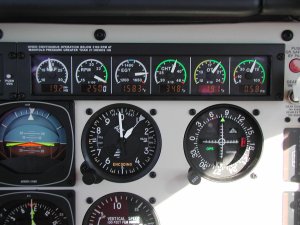
Moritz
engine gauges. |
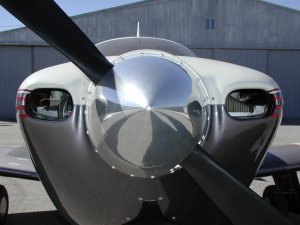
Ovation
cooling air inlets |
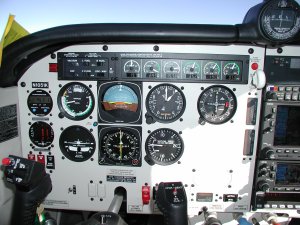
Ovation instrument panel
Like all the
other current production Mooneys, the M20R
has two batteries in the tailcone. So,
after checking them both for voltage level,
you should use the one with the highest
potential. If they are the same, use
the one not used during the last flight.
The battery that is not selected is kept
charged through a “trickle-charge” system,
so that it is fully charged and ready should
it be needed. Speaking of the
electrical system on the Ovation, once the
engine has been started, the aircraft’s
electrical needs are supplied by a huge
100-ampere, 28-volt DC engine-driven
alternator.
After
completing the preflight walkaround
inspection, it’s time to climb in, strap in
and get the big Continental cooking.
Engine start is very straightforward if you
remember one thing. Fuel…lots of fuel
is needed to start the 550 when the OAT is
low. When it is cold (like below
40-degrees F) I use the “High Boost Pump” to
prime for start fuel. I think it’s
almost impossible to flood this Continental
when it is cold outside. This is one
place that I disagree with the Mooney
checklist during cold weather starts.
The “Low Boost Pump” doesn’t seem to get
things done and the starts take longer.
However, since this airplane had been flown
prior to my departure from Kerrville, I used
the “Hot Start Procedure” of:
1.
Throttle – Full
Open
2.
Mixture – Idle
Cut Off
3.
Boost Pump -
High for 5 seconds or Low for 15 seconds
4.
Throttle – Idle
(then two half-turns in for the proper idle
RPM of 800 – 1000)
5.
Mixture – Full
Forward
6.
Starter Switch
– Turn and Push
This works
every time for me, so soon the IO-550-G6 was
making a throaty rumble beneath the long
sleek cowling. And the Ovation cowling
is a true thing of beauty and a design
marvel. By paying close attention to
airflow dynamics, the Mooney engineers have
designed a cowling for the M20R that doesn’t
need cowl flaps to aid engine cooling in
flight. It has small; oval openings
behind the propeller that ram the cooling
air into the upper deck of the engine bay.
Then, through the use of carefully designed
baffles, the airflow is directed downward
across the cylinder cooling fins and then is
drawn out through two aerodynamically
designed “blisters” around each exhaust
pipe. These blisters create an airflow
pattern and a “low pressure area” that draws
the cooling air through the engine bay from
the top down and out through the bottom of
the cowling and eliminate the need for cowl
flaps with their resultant drag. This
works quite well during most segments of
flight, but a word of caution here.
During hot weather operations, with extended
ground time, the small openings in the front
don’t seem to draw enough cooling air into
the engine bay. Oil temperatures (the
same air used to cool the cylinders is used
to cool the oil in the oil cooler) can
approach the Red Line, especially if the
airplane isn’t positioned facing into the
wind. In the summer, I work hard to
reduce the amount of ground time to try to
control this.
|

LCD
instruments. |
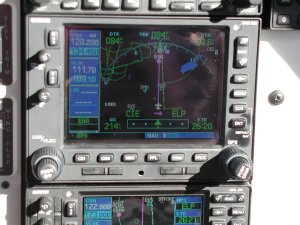
Garmin GS |
Now that the
engine is running, I can turn-on the Radio
Master Switch (used to control all the
avionics) and get my GPS flight plan loaded
into the Garmin GNS-530 GPS Navigator.
The panel in N1051K is representative of the
standard that is today’s high performance
general aviation “all weather” airplane.
Central in the avionics suite is a pair of
Garmins – a GNS-530 sits atop a GNS-430.
These two radios each feature an IFR Enroute
and Approach certified Global Positioning
System Navigator, a VHF communications radio
and a VOR receiver with Glide Slope.
Add to this the Bendix King KFC-225 2-axis
Digital Flight Director Autopilot, a Garmin
GTX-327 Transponder and GMA-340 Audio Panel
and we have a very capable IFR traveling
machine. N1051K also has the optional
Wx-500 Stormscope® and the Goodrich Skywatch®
which both display on the 530 and the 430.
The other notable options consist of a JPI
EDM700 Engine Monitoring System, and (very
important in the hot southwest) Factory Air
Conditioning.
With the
KCS-55A Slaved HSI system, polished spinner
and speed brakes as standard equipment, the
2002 Ovation2 is a functional and good
looking cross-country performer. And I
get to try it out.
Now that the
big-bore Continental is running, let’s talk
a little about this new engine. The
IO-550-G6 installation in the Ovation is
unlike other 550 Continental engines
installed in other airframes. In ’94
Mooney was the first OEM (Original Equipment
Manufacturer – another name for aircraft
manufacturer) to use the all-new “balanced
induction, crossflow head” IO-550 engine.
Until Mooney, all production aircraft use of
the 550 was the “straight-pipe” version and
the tuned induction engine was only in a
handful of home-built airplanes.
Mooney also introduced the “soft isolator
bedmount” system on the Ovation with tuned
engine isolators. All this makes for a
smooth, quiet cockpit even during high power
operations, and a very efficient engine.
A little
information about N1051K is necessary.
With an empty weight of 2397 pounds, 51K had
a useful load of 971 pounds to bring it to
the maximum takeoff weight of 3368 pounds.
This means that 2 FAA Standard 170-pound
individuals and full fuel (89 gallons
useable) would leave room for 113 pounds of
baggage (maximum baggage capacity is 120
pounds). However, it is very seldom
that a pilot will need or want all 89
gallons of avgas. With an average fuel
burn of 14 GPH (at 65% power), 89 gallons
would give over six hours of endurance.
This is much more than most pilots will
want, so something less than full fuel would
yield an increase in payload. Drop the
fuel quantity to 60 gallons (4.2 hours @
65%) and you still have a range in no wind
of over 550 NM with an hour and 12 minutes
reserve. With this fuel load, 51K
could carry 622 pound of people and bags.
That’s 3, 175-pounders and 50 pounds of
bags. Or, Mom and Dad (at 175 and 130)
plus kid #1 (at 75 pounds) and kid #2 (at 75
pounds) and still have 120 pounds available
for baggage. The Ovation, even
equipped with air conditioning, can carry a
wide variety of loading possibilities.
Today, my
takeoff weight is 123 pounds below maximum,
so with the conditions at Kerrville
(temperature 18-degrees C, DA 2500’, no
wind) – my takeoff distance will be 3200’
using under 2000’ of runway for ground
roll.
With my GPS
route stored in the Garmin, and a clearance
from Houston Centre, after a normal run-up
I’m ready to see what this bird will do.
Power is smoothly applied until I have full
throttle and away we go. Now most
folks who have flown the original Ovation
will notice that the O2 doesn’t accelerate
quite as crisply as its older brother with
the extra propeller blade. This is the
result of the two blades and a low pitch
stop mandated by a disputed FAA rule
interpretation during certification.
It’s funny how much static thrust one
additional propeller blade adds, however
this may be more a tactile perception and
not really true as the takeoff distance
numbers for the two models are very close.
Back-pressure
on the control wheel at 65 KIAS and up we
go. After confirming a positive rate
of climb, the wheels come up followed
closely by the 10-degrees of takeoff flaps.
With climb power of full throttle and 2500
RPM set, the VSI settles on 1200 FPM at VY
of 105 KIAS. Since 51K has only 8
hours on it’s hobbs meter and is still in
ring seating, I reduce the pitch for a more
“engine cooling friendly” 120 KIAS which is
cruise climb airspeed. This results in
a VSI reading of 1000 FPM as we are quickly
through 4000 feet enroute to our 8000-foot
clearance limit. The following table
shows the climb rate information for this
short climb to cruise altitude. On a
subsequent flight, I made an unrestricted
climb from a 1000’ takeoff altitude to
11,000 feet and that table is also
included.
|
Altitude |
IOAT |
MP/RPM |
Fuel Flow |
IAS |
ROC |
|
2000 |
18 C |
FT/2500 |
23.4 |
105 |
1200 |
|
3000 |
17 C |
FT/2500 |
23.1 |
120 |
1000 |
|
4000 |
15 C |
FT/2500 |
23.1 |
120 |
1000 |
|
5000 |
12 C |
FT/2500 |
23.0 |
120 |
985 |
|
6000 |
11 C |
24.2/2500 |
23.0 |
120 |
960 |
|
7000 |
8 C |
23.4/2500 |
22.6 |
120 |
850 |
Another flight,
takeoff weight 3358:
|
Altitude |
IOAT |
MP/RPM |
Fuel Flow |
IAS |
ROC |
|
1000 |
20 C |
FT/2500 |
24.6 |
120 |
1050 |
|
2000 |
19 C |
FT/2500 |
24.3 |
120 |
1000 |
|
3000 |
16 C |
FT/2500 |
24.3 |
120 |
1000 |
|
4000 |
14 C |
FT/2500 |
24.1 |
120 |
975 |
|
5000 |
12 C |
FT/2500 |
23.5 |
120 |
950 |
|
6000 |
11 C |
FT/2500 |
23.1 |
120 |
950 |
|
7000 |
8 C |
24.1/2500 |
23.0 |
120 |
920 |
|
8000 |
6 C |
23.6/2500 |
22.8 |
120 |
890 |
|
9000 |
5 C |
23.0/2500 |
22.1 |
120 |
860 |
|
10000 |
3 C |
22.1/2500 |
21.6 |
120 |
780 |
The KFC-225
autopilot with altitude preselect, made a
smooth level-off at 8000 feet just as
Houston Center cleared me GPS direct to El
Paso (ELP), direct to destination – Tucson’s
Marana Northwest Regional. This
resulted in almost a straight line
westbound.
Once level, I
referred to the Cruise Power Chart on the
Pilot’s sun visor and set full throttle (I
couldn’t quite get 75% which was my desire)
and 2400 RPM and figured that the big
Continental was producing about 72% power.
With a fuel flow (leaned to 50-degrees rich
of peak EGT) of 15.1 gallons of gas per
hour, and a GPS ground speed of 189 KTS, my
89 gallons of fuel would take me to the
destination 646 NM away and leave 31 gallons
or more than 2 hours of reserve.
Checking TAS
using the Garmin, we were clocking along at
187 KTAS, so the wind was not much of a
factor, being almost a dead crosswind
component of little velocity. Since I
was dealing with a deadline (I hate using
the word “dead” in an airplane) on my
arrival in Arizona, a full-out test of the
airplane’s performance would have to wait
until the return trip to Kerrville some 4
days from now.
Instead I
settled back and enjoyed the flight west.
The autopilot, talking to the GPS through
the HSI, kept us moving steadily toward our
destination, and as the sun set, I was
wondering if it could possibly get any
better. Soon, it was time to turn on
some cockpit lights, and here is another
area in which the newer Mooneys shine (no
pun intended!). Cockpit lighting is
superb. Flight instruments are
individually lighted and there are small
post lights for important switches not
backlit. In addition, there are two
glareshield flood lights that can light the
entire panel from harsh bright (something
I’d use when in the vicinity of lightening
flashes) to a soft subtle glow. I
don’t think it would be possible not to be
able to find a combination of instrument and
glareshield lights that wouldn’t please
everyone. Just be careful of one
thing. When the navigation lights are
turned on, the annunciator panel lights
automatically dim. This is great at
night, but forget to turn them off again
during daylight and your heart rate will
increase when you can’t see the green “Gear
Down” light!
Because of MEA
requirements, ATC step-climbed me to 11,000
as we approached Tucson. Still, the
Ovation clicked-off 178 knot TAS numbers
even though the power was down around 60%.
As we crossed the mountains east of Tucson,
still at 11, I could see the beacon at
Marana at 12 o’clock and only 30 NM ahead.
Time to start down and here’s where those
standard speed brakes really come in handy.
Power back to 20”/2500 RPM, roll the nose
down to peg the airspeed at the top of the
Green Arc (174 KIAS) and with the brakes
out, the VSI settles on 1000 FPM down.
This helps keep the engine temperatures
comfortably in the Green (I did watch the
JPI – it will show rate of cooling) and very
soon we were on the downwind. As the
autopilot levels off, power continues back
to about 16" and at 140 the gear comes down.
With another slight reduction in power, we
are soon at 110 which is flap speed, and
once the gear and flaps (takeoff position)
are set, we can again reduce the power
slightly and begin to descend toward the
blackness that surrounds Marana. One
of my least favorite things to do at night,
especially in mountainous terrain, is to
land at a strange airport. Thank
goodness for all the lights Mooney puts on
the Ovation. With a landing light on
each wing, a taxi light on each wing, white
recognition lights on each wing, we light up
the sky like a Boeing.
Normally, I
like to fly between 90 and 100 on base while
descending at 500 FPM, and then turn final
and put the rest of the landing flaps (the
Ovation has flap preselect set at TO =
10-degrees and LDG = 33-degrees) down.
Then slowing to a normal landing Vref of 1.3
VSO or about 75 KIAS on short
final, I will cross the fence at 1.2 Vref
before entering the flare. Trimming
with the standard electric trim, and I make
a smooth touchdown. How come my best
landings come when I’m alone?

No
cowl flaps needed
When we talk
about landings in the Ovation or any of the
new generation long body Mooneys (M20M, M20R
or M20S) we must talk about the landing
attitude. As I mentioned earlier, the
long bodies sit with about a positive 4.5
degrees pitch attitude on the ground.
Pilots moving into the newer aircraft from
one of the shorter length Mooneys (M20K or
earlier) will immediately notice this
difference when they first sit in the
cockpit. Now thinking about sight
picture and pitch attitude during the flare
for landing, most aircraft will need about +
5-degrees during the round out to keep the
nose wheel off the runway until the mains
are on. This works quite well for all
the Mooneys except the Ovation, Eagle or
Bravo. With an almost 5-degree nose up
attitude sitting level, the pitch attitude
is going to need to be higher during landing
in order to land on the main wheels before
the nose. One of the biggest
transition problems I have found for pilots
moving into these long Mooneys is the
landing – more specifically, landing on the
nose first or all three simultaneously.
Either action can quickly lead to a porpoise
and the outcome of this isn't very pretty.
Pilot must develop a different sight picture
when landing these new Mooneys. Where
5-degrees worked before, 8-degrees is
necessary now. This just takes
practice and the help of a competent
instructor familiar with long-body Mooneys.
As with all
Mooneys, airspeed control during the final
approach is key. Fly too fast and the
airplane will float on a cushion of air
forever.
Fly the correct
approach speed (1.3 V Stall for the weight
and flap configuration) on short final, have
the airplane configured for landing and
trimmed and the touchdown is normal.
If we use a target altitude of 50 feet above
the runway to achieve this, then the last 50
feet is very easy. If we are still
chasing the airspeed or trim at 50 feet AGL,
then a go around might be advised in order
to set it up again. Seldom do good
landings come from bad approaches!
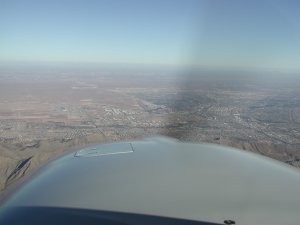
El Paso
slides under the nose
Also, since these longer Mooneys have larger
(and heavier) engines up front, I recommend
liberal use of the electric trim to relieve
the control wheel force during the flare.
With just two people in these airplanes, the
CG during landing is well to the front of
the envelop and the rotational forces are
quite high (it’s an inertia issue not
control effectiveness). I’ve noticed
the after my best landings, the elevator
trim is almost completely nose-up under
these situations. One area that seems
to be a concern to some when they think
about landing a Mooney with full flaps (the
recommended configuration) and a bunch of
nose-up trim is the go around. This is
just not an issue. The go around
procedure in the Ovation (as well as all
other Mooneys) is:
1.
Pitch to 8-degrees nose up while
simultaneously smoothly applying full
takeoff power to climb at VX.
2.
Retract the flaps to the takeoff position
(if they are full down).
3.
Verify on the VSI and Altimeter that there
is a positive rate of climb.
4.
Retract the landing gear.
5.
Retract the remaining flaps.
6.
Target VY if clear of obstacles.
7.
Throughout this procedure, use electric and
manual trim as necessary to reduce the
pressure on the control wheel.
This is easily accomplished even without
electric trim, and during the process, the
control forces needed to fly the correct
pitch attitude or airspeed are well within
those even the smallest and lightest pilots
posses.
Three hours and fifty minutes after
departing Kerrville, N1051K had arrived at
it’s new home and the proud owner was
carefully putting her to bed in her new
hanger…what an airplane!
Four days later, after accomplishing more
than 12 trouble-free hours of flight
training, I am once again in 51K ready to
depart back to Kerrville to return the
airplane to the factory for it’s first oil
change. During the almost 16 hours of
cross-country and rugged flight training, we
only used 1 ½ quarts of oil, so the rings
should be seating correctly.
On
the return (Marana to San Antonio – 678 NM -
3 hours, 25 minutes, 49 gallons of fuel) I
did get the chance to do some speed runs at
11,000 feet to check the true airspeed.
